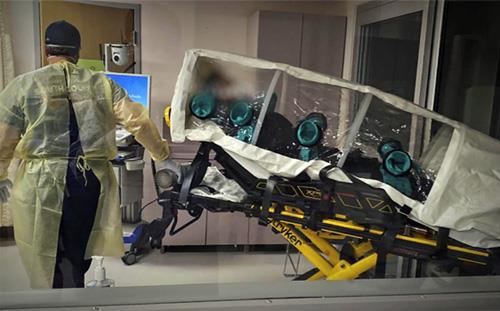
Finding a TV program about the coronavirus pandemic is about as hard as, um, turning the TV set on.
But for a good compact update, sorting out many of the conflicting claims and arguments, it’s worth checking out Frontline’s Coronavirus Pandemic, airing Tuesday at 9 p.m. ET on PBS (check local listings).
Correspondent Miles O’Brien briefly recounts how the virus first seemed to take hold and talks mostly to medical personnel about whether our current containment strategy appears to be working and what the most prudent course forward might look like.
Much of it will sound familiar to anyone who has been following the discussion, or at least the rational parts of it.
O’Brien loosely frames his report as “A Tale of Two Washingtons,” with the response of Washington state Gov. Jay Inslee contrasted with much of the response from President Donald Trump in Washington, D.C.
Washington state was the U.S. port of entry for the virus, and Seattle, the first city where it rapidly became clear this was more than your garden-variety seasonal flu.
O’Brien references the Patient Zero in the U.S., the first to be diagnosed with COVID-19 and, alongside Tom Hanks and Boris Johnson, one of its highest-profile survivors.
The U.S.’s Patient Zero was treated with the drug Remdesivir, which was developed to fight other diseases, but has shown promise against COVID-19 and is one of many drugs currently in clinical tests.
Obviously, the virus has spread well beyond that patient and Washington, however, and O’Brien tracks some of the signs and subsequent warnings. He contrasts the concern of the World Health Organization and American medical personnel with early assurances by President Trump that “we have it totally under control.”
Once it was clear we did not, O’Brien suggests, the issue became our response, which in the “hot spot” states was unprecedented widespread social distancing. The medical personnel interviewed here unanimously say that was the right call and warn against lifting restrictions too rapidly, lest the virus resumes its initial rapid spread.
O’Brien notes that’s not the opinion expressed in the recent “liberate” rallies, where activists have called for an end to government-ordered social limitations. President Trump has signaled his endorsement of their goal.
The Frontline report does not get into the debate over the economic implications of the present lockdowns and business closures, focusing on the medical aspect of the virus itself.
Going forward, his commentators say, the most critical need is widespread testing, to determine the actual extent of the virus’s spread. Toward that end, there remain shortages of vital materials essential for that testing.
Raising those issues takes O’Brien into some technical areas like swab tips with the proper chemicals, which might make some viewers’ eyes glaze over. But as we rapidly learn more about coronavirus, he suggests, those medical nuts and bolts will be what eventually enables us to understand it and bring its threat under control.
Frontline strongly suggests the more cautious approach of states like Washington is the prudent and safer course. But whatever a viewer’s own conclusions, O’Brien offers a good summation of where we are and where we need to go.